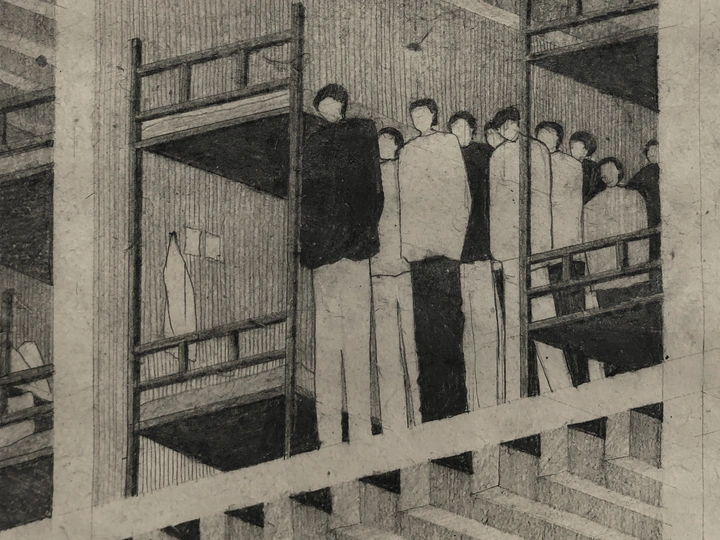Reading Space

Fiachra McCarthy
Gjiltinë Isufi and Fiachra McCarthy explore speculative approaches to architecture by engaging with overlooked buildings and contested geographies. Through drawings and installations, they explore architecture as a medium to uncover suppressed narratives. Their recent work includes the investigation of the lost history of ‘New Geneva’ as part of their residency in Ireland, funded by Culture Moves Europe (2024). Their work will be exhibited at the AATE Festival in Galway, Ireland (2025) and their earlier work has been exhibited at the ENSA Saint-Ètienne in France (2023).
Gjiltinë is an architect and researcher based in Brussels. As a recipient of the FWO Fellowship, she is currently conducting a PhD at KU Leuven with the project ‘In Space We Read Trauma: Disclosing Microhistories in Kosovo, 1980-1999’. The project focuses on the development of a methodological framework for spatially investigating traumatic experiences. Gjiltinë is teaching at KU Leuven on the intersection of trauma and space. Her recent work will be part of the Aarhus Biennale (2026), and earlier works have been nominated for the EUmies YTAA (2023), presented at the Manifesta Biennial (2022), awarded the Laureate Prize at KU Leuven (2022), and awarded the Lars Lerup Award at the Dessau Institute of Architecture, Germany (2019).
Fiachra is an architect and artist working between Belgium and Ireland. He studied architecture at TUD, Dublin and KU Leuven, Brussels, with further studies at HSLU, Luzern, and UIC, Barcelona. Fiachra’s practice sits at the intersection of art and architecture, spanning work in Ireland, Belgium, and China. He is also the co-founder of the Brussels based art and scenography duo F//AAT. His works include a pavilion design for the Affair Festival in Belgium (2025), co-creating Mangé at GIFTSHOP (2025), and a personal exhibition of his duo at VONK, Hasselt (2024). His work has been exhibited at De Singel in Antwerp (2024) and featured in The Architectural Review (2022).
What contribution can an architect’s toolkit offer in the disclosure of microhistories? To explore this question, this project investigates the prison of Gjilan, one of the most notorious prisons in former Yugoslavia. Situated in Kosovo and active during the 1980s–1990s, the prison held numerous Kosovo Albanian political prisoners, tortured and tormented in inhumane conditions. Today, the prison remains standing but largely unacknowledged.
Through oral testimonies, prison letters, and walk-alongs, the project focuses on the disclosure of spatial connections through the production of architectural documents. Maps, sections, models, and installations become instruments for discovery, moving away from their traditional representational role. In the case of the prison, these artefacts disclose spatial connections which would otherwise remain invisible: how window gaps allowed for messages to pass through, how sound traveled from torture rooms to cells, or how doors became walls and walls became communication tools. Through this methodology, the project aims to direct attention towards buildings often dismissed as stylistically insignificant. Moreover, it aligns with an expanded notion of evidence within architectural history, centering storytelling and drawing over protagonist architects and iconic forms.
This study is part of a PhD project titled 'In Space We Read Trauma: Disclosing Microhistories in Kosovo, 1980–1999'. Findings on these shifting borders of confinement will be published in the ADH journal (2025), and its architectural artefacts will be exhibited at the Aarhus Biennale (2026). To take this methodology further, we are now investigating how these spatial findings can inform temporary uses of buildings. We focus on the adjacent public space which (dis)connects the prison to the city theatre, marked by collapsing barbed wires and decaying facades. Here, practices of performance will offer a means for architecture to become an active site of discourse.